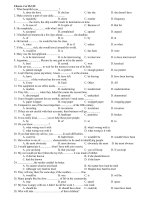general chemistry
Bạn đang xem bản rút gọn của tài liệu. Xem và tải ngay bản đầy đủ của tài liệu tại đây (605.59 KB, 25 trang )
Prentice-Hall ©
2002
General Chemistry:
Chapter 2
Slide 1 of 25
Chapter 2: Atoms and the Atomic Theory
Philip Dutton
University of Windsor, Canada
Prentice-Hall © 2002
General Chemistry
Principles and Modern Applications
Petrucci • Harwood • Herring
8
th
Edition
Prentice-Hall ©
2002
General Chemistry:
Chapter 2
Slide 2 of 25
Contents
•
Early chemical discoveries
•
Electrons and the Nuclear Atom
•
Chemical Elements
•
Atomic Masses
•
The Mole
Prentice-Hall ©
2002
General Chemistry:
Chapter 2
Slide 3 of 25
Early Discoveries
Lavoisier 1774 Law of conservation of mass
Proust 1799 Law of constant composition
Dalton 1803-1888 Atomic Theory
Prentice-Hall ©
2002
General Chemistry:
Chapter 2
Slide 4 of 25
Dalton’s Atomic Theory
Each element is composed of small particles called atoms.
Atoms are neither created nor destroyed in chemical reactions.
All atoms of a given element are identical
Compounds are formed when atoms of more than one element
combine
Prentice-Hall ©
2002
General Chemistry:
Chapter 2
Slide 5 of 25
Consequences of Dalton’s theory
In forming carbon monoxide, 1.33 g
of oxygen combines with 1.0 g of
carbon.
In the formation of hydrogen
peroxide 2.66 g of oxygen combines
with 1.0 g of hydrogen.
Law of Definite Proportions: combinations of elements are
in ratios of small whole numbers.
Prentice-Hall ©
2002
General Chemistry:
Chapter 2
Slide 6 of 25
Behavior of charges
Prentice-Hall ©
2002
General Chemistry:
Chapter 2
Slide 7 of 25
Cathode ray tube
Prentice-Hall ©
2002
General Chemistry:
Chapter 2
Slide 8 of 25
Properties of cathode rays
Electron m/e = -5.6857 x 10
-9
g coulomb
-1
Prentice-Hall ©
2002
General Chemistry:
Chapter 2
Slide 9 of 25
Charge on the electron
From 1906-1914 Robert Millikan showed ionized oil drops can
be balanced against the pull of gravity by an electric field.
The charge is an integral multiple of the electronic charge, e.
Prentice-Hall ©
2002
General Chemistry:
Chapter 2
Slide 10 of 25
Radioactivity
Radioactivity is the spontaneous emission of radiation
from a substance.
X-rays and γ-rays are high-energy light.
α-particles are a stream of helium nuclei, He
2+
.
β-particles are a stream of high speed electrons
that originate in the nucleus.









